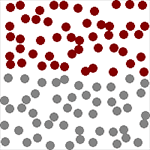A Brief History of Sir Isaac Newton
Isaac Newton was 19 when he began his scientific studies at Cambridge University in England. He arrived at school in 1661 and began studying the work of Aristotle. The teachings of Aristotle had been the primary theories of science and nature for almost two thousand years. Aristotle had tried to explain the workings of the universe and nature in qualitative rather than quantitative terms. There were many more modern theories of nature and how it worked, but when Newton began his studies at Cambridge, all the universities taught only Aristotelianism.

While a student at Cambridge, Newton soon found himself more interested in the teachings of the French philosophers René Descartes and Pierre Gassendi than of Aristotle. Gassendi was responsible for the revival of atomism, which offered another method to explain the workings of nature. Both Descartes and Gassendi were part of a group called mechanical philosophers. They believed the physical world was built of particles of matter which are in constant motion. The mechanical philosophers also believed that all phenomena of nature resulted from the interaction of these particles.

Newton was learning about particles and their interaction when he began his studies in math. In little more than a year he had mastered algebra, classical geometry, and the application of algebraic techniques to solve problems of geometry. Newton soon began to develop new math techniques, including calculus. Calculus was required to study motion. Without calculus, the study of physics would not have been possible. Armed with his natural mathematical talent and his knowledge of the mechanical philosophers, Newton was destined for a most remarkable career in science.
Many of Newton's experiments and discoveries were accomplished at a young age, but most were documented only in his notebooks. It was not until he was 42 years of age that he began to write. His first book was called Principia Mathematica Philosophiae Naturalis (Mathematical Principles of Natural Philosophy). It is generally accepted as the greatest scientific book ever written. Another of his books, Opticks (Optics), dealt with his work on light.
References:
Conceptual Physics (fourth edition). Paul G. Hewitt. Little Brown and Company. 1981
Introduction to Optics (second edition). Fran L. Pedrotti, S.J. and Leno S. Pedrotti. Prentice Hall, 1993.
"Newton, Sir Isaac" Britannica Online. Retrieved January 4, 1998.
Read more about: Seeing Color
Bibliographic details:
- Article: A Brief History of Newton
- Author(s): Dr. Biology
- Publisher: Arizona State University School of Life Sciences Ask A Biologist
- Site name: ASU - Ask A Biologist
- Date published:
- Date accessed:
- Link: https://askabiologist.asu.edu/brief-history-sir-isaac-newton
APA Style
Dr. Biology. (). A Brief History of Newton. ASU - Ask A Biologist. Retrieved from https://askabiologist.asu.edu/brief-history-sir-isaac-newton
Chicago Manual of Style
Dr. Biology. "A Brief History of Newton". ASU - Ask A Biologist. . https://askabiologist.asu.edu/brief-history-sir-isaac-newton
Dr. Biology. "A Brief History of Newton". ASU - Ask A Biologist. . ASU - Ask A Biologist, Web. https://askabiologist.asu.edu/brief-history-sir-isaac-newton
MLA 2017 Style

A painting of Sir Isaac Newton when he was 46 years old. The portrait is by by Godfrey Kneller.
Be Part of
Ask A Biologist
By volunteering, or simply sending us feedback on the site. Scientists, teachers, writers, illustrators, and translators are all important to the program. If you are interested in helping with the website we have a Volunteers page to get the process started.

